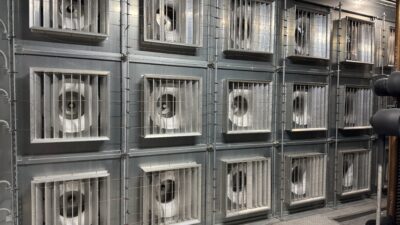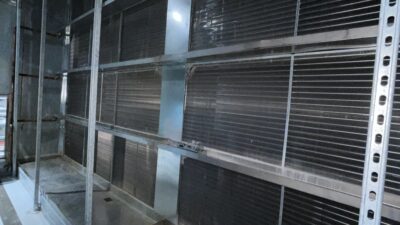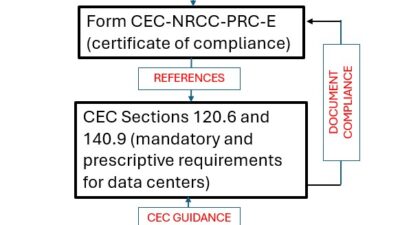ASHRAE 90.4 helps engineers move toward data center energy efficiency compliance.
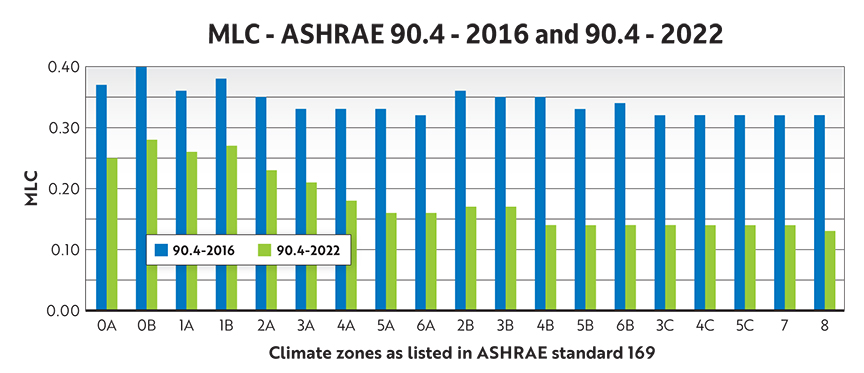
Learning objectives
- Understand the basics of determining data center energy efficiency through ASHRAE Standard 90.1: Energy Standard for Buildings Except Low-Rise Residential Buildings.
- Learn about ASHRAE Standard 90.4: Energy Standard for Data Centers and how it works with ASHRAE 90.1.
- Know how to apply ASHRAE 90.4 in data center design.
Data center insights
- When designing data centers, engineers must understand which codes or standards are needed to guide them.
- ASHRAE 90.4, published as a stand-alone document, requires that the prescriptive measures found in ASHRAE 90.1 must be met to achieve compliance.
In the International Energy Conservation Code (IECC) and ASHRAE Standard 90.1: Energy Standard for Buildings Except Low-Rise Residential Buildings framework, data centers are classified as commercial buildings and must follow either the IECC prescriptive path or ASHRAE 90.1 (defined as an alternative compliance path).
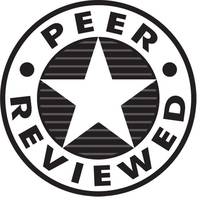
From rom 2001 to 2007, ASHRAE 90.1 changed very little with respect to data centers. The primary changes were made to address humidity control, outline when economizers are required, and defining baseline Heating, ventilation and air conditioning (HVAC) systems, which are used in calculating energy use performance.
Although Standard 90.1 had included updates for data center energy efficiency requirements, it was still trailing behind the rapid pace of advancements in computing technology. These advancements were having a significant impact on facility size, construction type and electrical and cooling systems. As municipalities across the U.S. began to encounter increasing data center projects, building code officials needed a way to review and assess data center designs for permitting purposes.
Also, it was important that these standards and guidelines remain relevant despite ongoing advancements in computing technology. Over the years there have been several working groups and committees focused on data center energy efficiency. Much of the work that was done has worked its way into the current energy efficiency guidance documents.
ASHRAE Standard 90.1-2013 of the was the first to include detailed guidance on achieving data center energy efficiency. It also came at an advantageous time as the data center community continued to advance in the design, construction and operations of highly sophisticated, resilient and energy-efficient facilities.
ASHRAE 90.1-2013 was the first edition with an alternate compliance path for data centers using power usage effectiveness (PUE) as the compliance metric. The compliance path includes guidelines for calculating PUE using ASHRAE 90.1 Appendix G simulation methodology. The 2016 edition of Standard 90.1 contained the same language as the 2013 edition. While the 2013 and 2016 standards reduced some uncertainty in how data centers meet energy efficiency requirements, it was a needed stopgap until ASHRAE released its new data center energy standard.
Still, engineers and code enforcement officials faced challenges in validating compliance with the ASHRAE 90.1 requirements, escalating the need for a dedicated energy standard for data centers. However urgent the need for a new standard, ASHRAE followed its procedure for standards development using a consensus-driven process, with representation from a wide range of constituents, including owners, developers, engineers and equipment manufacturers. The new standard would be published as an independent document but would fit within the framework of ASHRAE 90.1.
ASHRAE Standard 90.4 for data center energy efficiency
In mid-2016, ASHRAE Standard 90.4: Energy Standard for Data Centers was published. At just more than 60 pages, ASHRAE 90.4 doesn’t seem as detailed as other standards such as ASHRAE 90.1, which is more than 450 pages. The brevity of ASHRAE 90.4 is by design — instead of trying to weave in data center-specific language into the existing ASHRAE 90.1 standard, ASHRAE opted for a separate standard that applies only to data centers and relies on Standard 90.1 for normative references, such as requirements for building envelope, service-water heating, lighting and others. This approach avoids doubling up on future revisions to the standard, eliminates overlap and ensures that ASHRAE 90.4’s focus remains exclusive to data center facilities.
The new ASHRAE 90.4 standard also includes the compliance methodology mechanical and electrical engineers need to demonstrate how their design meets the energy efficiency requirements. This includes new terminology and calculations: Design and annual mechanical load component (MLC) and electrical loss component (ELC). ASHRAE clearly states that these values should not be used to judge efficiency outside of 90.4 and are not analogous to PUE developed by The Green Grid. The standard includes compliance tables with the maximum MLC for the 19 ASHRAE climate zones.
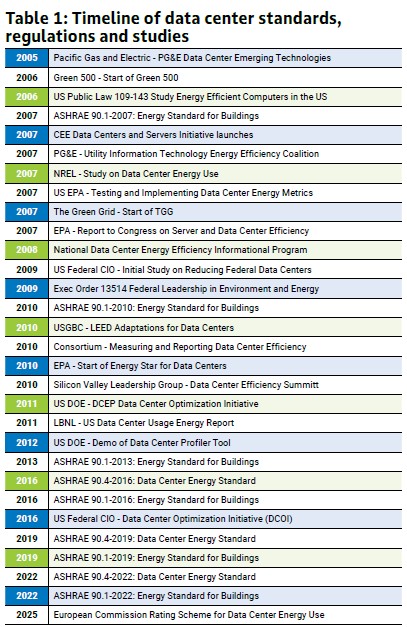
After Standard 90.4 was released and put to use, many engineers and code enforcement officials had a clearer understanding of how designs must be judged to meet energy efficiency requirements for data centers. The new standard provided a solid framework for determining data center energy compliance.
Aside from the obligatory changes needed after releasing a new standard, ASHRAE also included significant revisions, deletions and new requirements. While all of this was needed to keep up with the pace and innovations of data center growth, it was critical that the new Standard 90.4 would remain relevant as new generations of ITE systems and data center cooling and power design would continue to evolve.
As Standard 90.4 began to be applied to data center projects, a new edition of the Standard 90.1 was released. The new standard no longer contained details for computer room energy efficiency compliance, which were previously present in ASHRAE 90.1-2013 and 2016. Also, the ASHRAE 90.1-2019 edition was published concurrently with the new ASHRAE 90.4-2016 version. The new Standard 90.1 was the first to offer an alternative compliance path for computer room systems using the Standard 90.4. Section 6.6.1 in ASHRAE 90.1 now describes the requirements for using Standard 90.4 to demonstrate compliance.
ASHRAE 90.4-2019: improvements and new interpretations
Based on several factors, including advancements in HVAC and electrical equipment, ITE system design and feedback from the industry, ASHRAE released the second edition of Standard 90.4 in 2019. Many of the changes focused on increasing energy efficiency requirements.
For example, the maximum MLC values required for compliance were lowered, increasing the efficiency requirements. In keeping with ASHRAE TC 9.9 recommended thermal guidelines, ASHRAE stated that the revised MLC values are conservative and can be achieved with or without an air-side economizer. Also, the design MLC compliance path had been replaced with a more accurate approach using the maximum annualized MLC calculation. (TC 9.9 is concerned with all aspects of mission critical facilities, data centers, technology spaces and electronic equipment/systems.)
Standard 90.4 contains two tables listing the maximum values for annualized MLC based on ITE capacity from ≤ 300 to > 300 kilowatts. Annualized MLC is the sum of all energy required for cooling, fans, pumps and heat rejection equipment, divided by the energy for the data center ITE design. Each table associates a maximum annualized MLC value with a climate zone as defined by ASHRAE Standard 169: Climatic Data for Building Design Standards.

The annualized MLC equation was also revised from ASHRAE 90.4-2016. Before the revision, the annual energy use calculation assumed that the ITE systems always ran 100%. But to demonstrate the impact of part-load conditions on cooling equipment and overall system design, the calculation for the annualized MLC now requires the energy use of the HVAC system to be calculated at 25%, 50%, 75% and 100% of the ITE load. Once the annualized MLC is calculated, it is compared to the maximum annualized MLC values in Standard 90.4.
There were also changes to electrical system compliance. The maximum ELC values for the uninterruptible power supply (UPS) segment for electrical systems have been lowered, reducing the maximum allowable overall ELC. ASHRAE indicates this was done to recognize efficiency improvements in data center electrical distribution equipment and UPS systems since the original release of Standard 90.4.
ASHRAE 90.4-2022: data center electrical efficiency and renewable energy
The next edition, ASHRAE 90.4-2022, introduced changes focused on improving energy efficiency and adapting to technological advancements in data centers (see Figure 4). These are key updates from the standard:
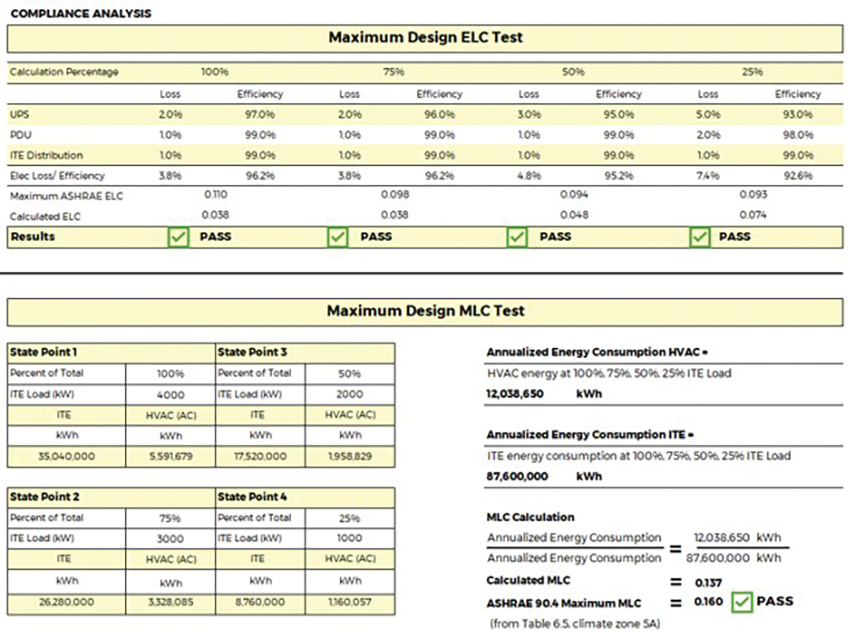
- The incoming service segment of the ELC was eliminated from the calculation.
- The maximum ELC values required for UPS segment compliance have again been lowered (also reducing the maximum allowable overall ELC).
- All ELC segment calculations must now be made at 25%, 50%, 75% and 100% of the design load, making the calculation methodology and output for the ELC congruent with the MLC.
- The calculations now require the inclusion of transformer efficiency curves in the distribution segment downstream of the UPS.
- Additional options were introduced for the mechanical load component calculations.
- A new alternative compliance path was introduced for the combined MLC and ELC used in considering onsite renewable energy deployments.
- Language was incorporated to encourage heat recovery. ASHRAE indicates that the credit calculation method is very specific to avoid double dipping.
Over the three editions of Standard 90.4, the updates were geared toward keeping up-to-date with power and cooling system technology and reflecting how data centers are designed. The implemented changes were prioritized to be most helpful and informative in designing and operating highly efficient, state-of-the-art data centers (see Figure 5).

